For various reasons I haven’t been out much lately so to keep things ticking over here are a few photo’s that I haven’t used on previous posts. There is no theme and they don’t appear in any particular order. I hope you enjoy.
Posted in Landscapes/Nature, tagged aber falls, afon lledr, bala railway, capel curig, conwy bay, dolwyddelan, floods, great orme, llandudno, llanrwst, Llyn Crafnant, llyn dinas, llyn nantlle uchaf, llyn ogwen, llyn tegid, llynau mymbyr, north wales, rhaeadr bach, snowdonia, taliesin monument, trefriw, tu hwnt i'r bont, wild ponies on December 6, 2009| 4 Comments »
For various reasons I haven’t been out much lately so to keep things ticking over here are a few photo’s that I haven’t used on previous posts. There is no theme and they don’t appear in any particular order. I hope you enjoy.
Posted in Landscapes/Nature, tagged autumn, autumn colours, autumn leaves, berries, bodnant gardens, north wales, sequoia on October 12, 2009| 1 Comment »
I have done two previous posts about Bodnant garden this year, in spring and summer. This post is mainly about the autumn colours so the pictures will do most of the talking.
There are still some colourful borders and some of the roses are still in bloom, but although today was a bright autumn day we’d had torrential rain (almost 2 inches) yesterday and the flowers had taken a battering.
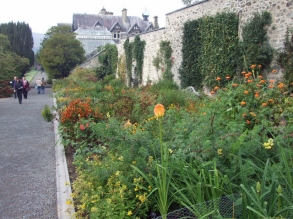
An autumn border, 7 October 2009

Autumn roses, 7 October 2009
There is still a lot of greenery, but this serves to show up the beautiful yellows, oranges and reds.
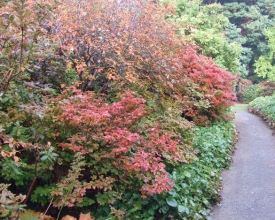
Shades of autumn, 7 October 2009
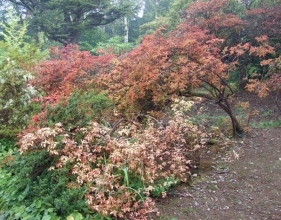
Shades of autumn, 7 October 2009

Autumn leaves, 7 October 2009
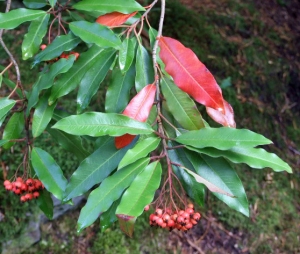
Autumn leaves and berries, 7 October 2009

Berries (Cornus kousa), 7 October2009
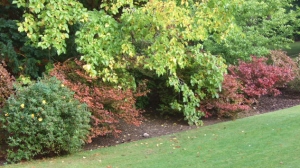
Shades of autumn, 7 October 2009
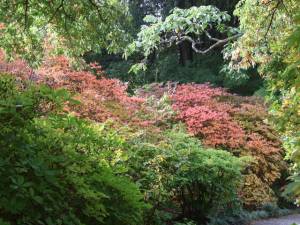
Shades of autumn, 7 October 2009
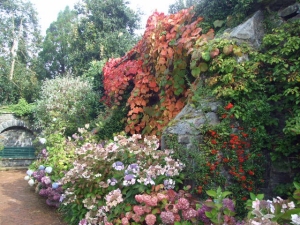
Autumn colours around the lily pond, 7 October 2009
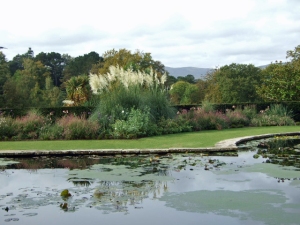
Autumn around the lily pond, 7 October 2009
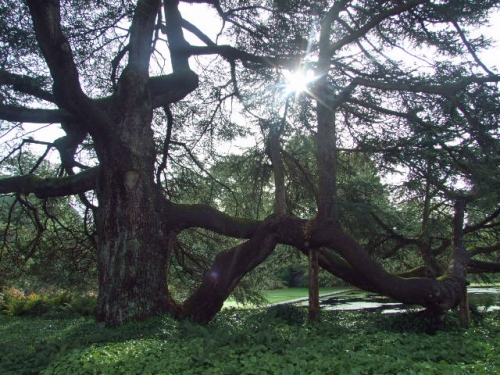
Autumn sun glinting through an old Cedar, 7 October 2009
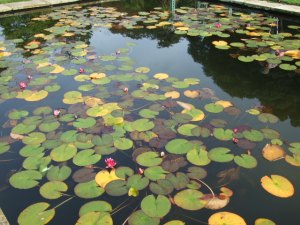
There are still a few water lilies, 7 October 2009
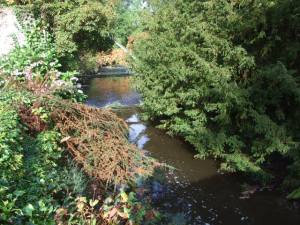
Shades of autumn, 7 October 2009

What are these strange things? 7 October 2009
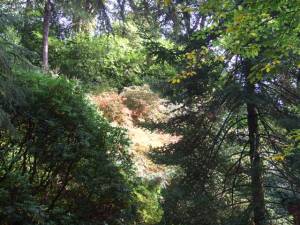
Splashes of autumn colour, 7 October 2009

A splash of autumn colour, 7 October 2009

Shades of autumn, 7 October 2009

Shades of autumn, 7 October 2009
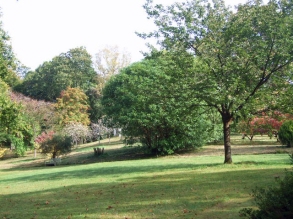
Shades of autumn, 7 October 2009
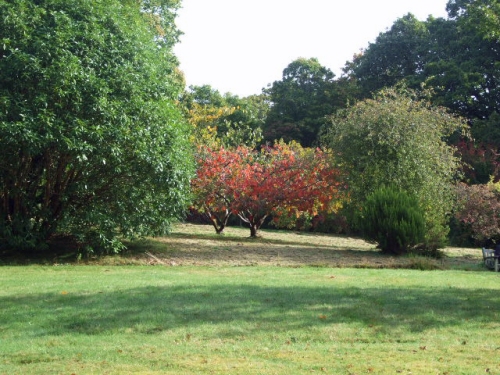
Shades of autumn, 7 October 2009

Shades of autumn, 7 October 2009
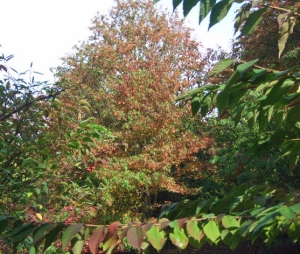
Shades of autumn, 7 October 2009

Shades of autumn, 7 October 2009
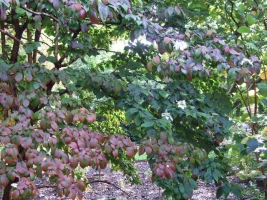
Shades of autumn, 7 October 2009

Autumn leaves, 7 October 2009
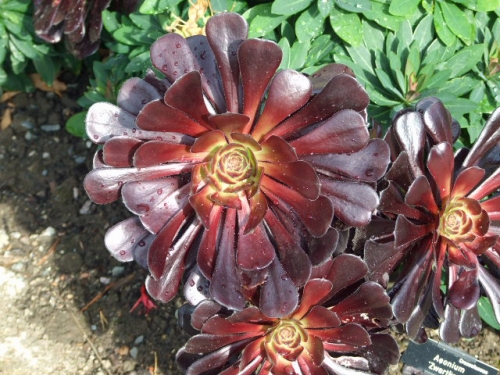
Shades of autumn, 7 October 2009
To round off this colourful walk around Bodnant garden here are some photos of the wonderful Sequoiadendron giganteun. These great trees are in the Dell and have grown to over 145 feet high.
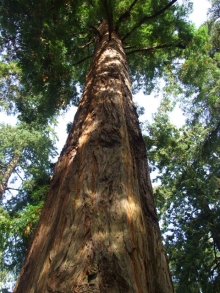
A Sequoiandrendron giganteun, 7 October 2009

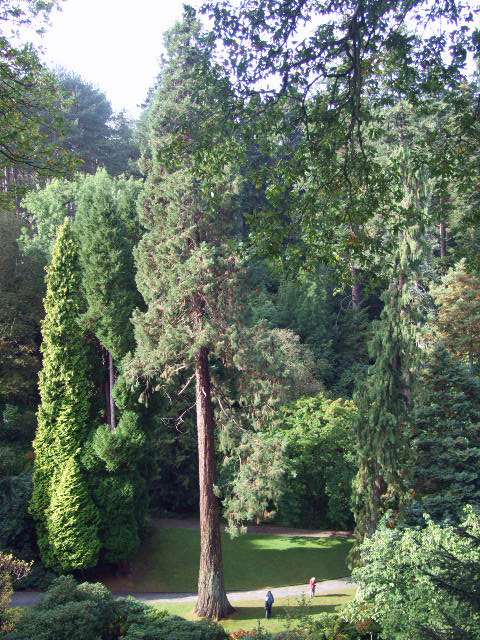
Sequoiadendron giganteun over 146 feet high. 7 October 2009
Bodnant garden is a wonderful place to visit at any time of the year, constantly changing but always a great day out.
More details about Bodnant garden can be found here: http://www.bodnantgarden.co.uk/
Posted in History, Landscapes/Nature, tagged caerdroia, conwy valley, cyffty mine, grey mare's tail, gwydr forest, hafna mine, labyrinth, lead mines, llanrwst, llyn parc, llyn sarnau, north wales, snowdonia on August 25, 2009| 9 Comments »
Saturday 25th. August dawned bright, with mist hanging over Afon Conwy. The sun quickly burned off the mist and I set off a few miles up the valley to Llanrwst where my days walk was to start.
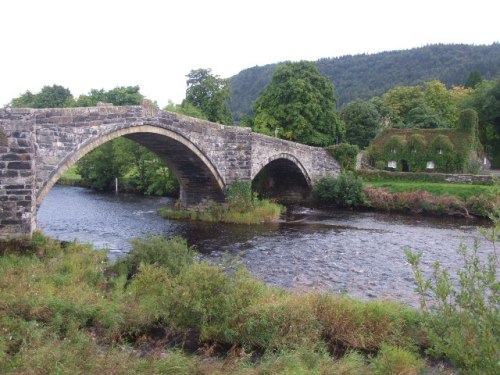
Y Pont Fawr and Tu Hwnt i'r Bont at Llanrwst, 22 Aug 09.
The bridge across Afon Conwy (Y Bont Fawr) was built in 1636, reputedly by Inigi Jones. The building at the western end of the bridge is Tu Hwnt i’r Bont (beyond the bridge). This cottage was built in 1480 and for a time served as a courthouse for the town. It is now a tea room owned by the National trust.
My walk started just across the road from Tu Hwnt i’r Bont and the first half mile or so took me along the banks of Afon Conwy.
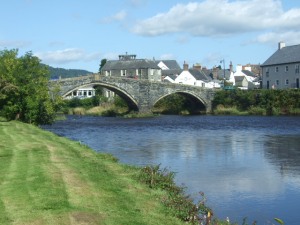
Looking back to Y Bont Fawr and Llanrwst, 22 Aug 09.

Afon Conwy looking towards Betws y Coed, 22 Aug 09.
After a short walk alongside the river I cut across the fields towards the forest.
Gwydyr forest is on the eastern flank of the Snowdonia National Park. It covers an area of about 17, 915 acres (28 square miles) and has lots of paths, mountain bike trails and horse ridind tracks.
The first mile or so into the forest was pretty steep as the path climbed up away from the valley, but there is a viewpoint part way up where you can sit at a picnic table and have a rest and a drink (and very welcome it was too).

Looking down the Conwy valley from the viewpoint, 22 Aug 09.
After a short rest it was back to the climb. More gradual now as I took the main forest track which is much used by mountain bikers.
This wasn’t the path I’d intended to take, but just before I reached the top of the hill I came across Caerdroia. This is a community project carried out by people who live in and around the forest. As it happens they were holding an open day and I was able to get a welcome cup of coffee and a sit down, all for the princely sum of 50p.

One of the sculptures in the labrynth, 22 Aug 09.
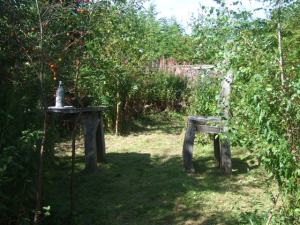
A giants table and chair in the labrynth, 22 Aug 09.
As you walk around the labrynth you are met by sculptures and strange objects. Today there were story-tellers and lots of other things going on. I wish I could have stayed longer, but I still had a long walk ahead of me. More information about the project can be found here; http://www.golygfagwydyr.org/achievements.php?page=2〈=e
Now though I had to carry on, up the last short part of the climb. I was now heading for Llyn Parc and soon got my first glimpse of the lake hidden deep in the forest valley.
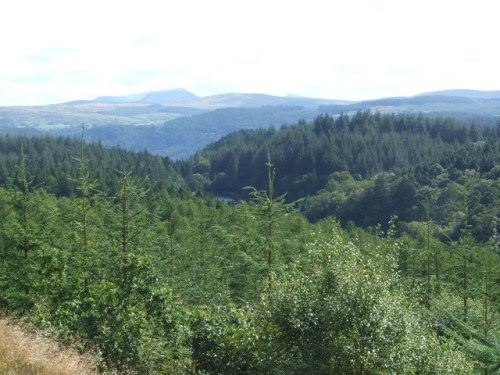
Llyn Parc hidden in a deep forest valley, 22 Aug 09.
Llyn Parc is a natural lake, but the southern end was dammed to raise the level for use of a nearby lead mine. The lake lies 664 feet above sea level and covers an area of 22 acres. It’s a long, narrow lake, lying in a “V” shaped valley.
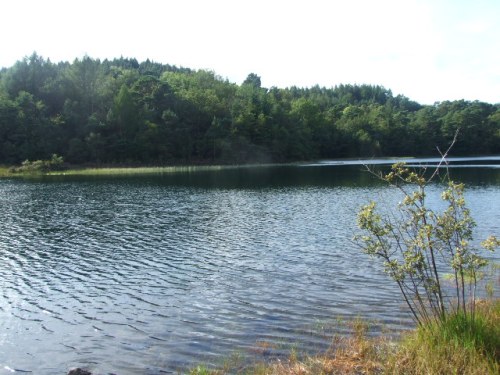
Llyn Parc, 22 Aug 09
After a walk along the shore of the lake I followed the stream at the southern end for a short way. This is the outflow which was used by the lead mine, and there are still relics of the mines around the area.

Relics of mines can be seen all over the area, 22 Aug 09.
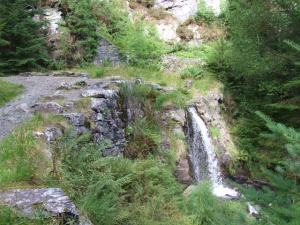
Remains of lead mine beside the waterfall, 22 Aug 09.
Now I walked along the shore of Llyn Parc, then it was back to climbing up away from the northern end and heading for another small lake and some more ruined mines. Walking along the forest tracks there were signs that autumn is not far away.
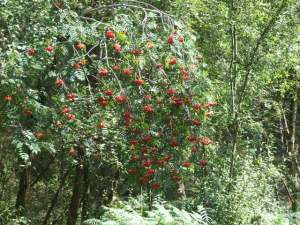
Lots of bright red Rowan berries, 22 Aug 09.

Leaves are already starting to change colour, 22 Aug 09.
As well as the signs of autumn though, there were also some colourful edges to the forest.
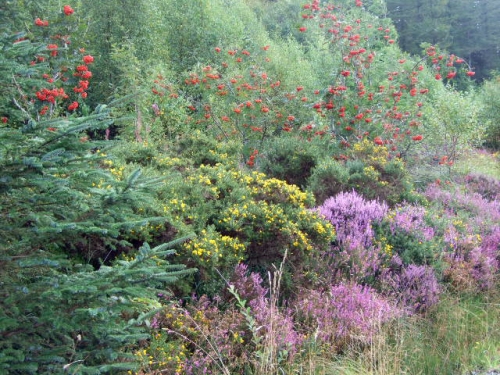
Colour at the forest edge, 22 Aug 09.
After a climb and walking around the hillside I then got some great views.

The view of Moel Siabod and the Snowdon range, 22 Aug 09.
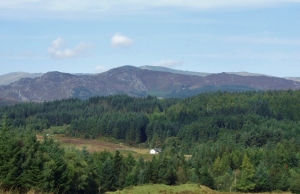
The view across the forest towards Llyn Crafnant, 22 Aug 09.
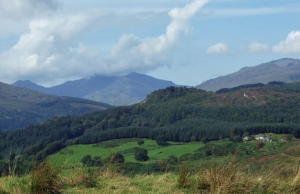
Cloud over the Snowdon horseshoe, 22 Aug 09.
Now I was almost at Llyn Sarnau. This is a small shallow lake with reeds growing along a lot of it. It’s one of the smaller lakes in the area, covering only 3 acres. As I approached it there were dozens of buuterflies flitting around the edge of the forest. Unfortunately they don’y like to stop and pose for photos, so I only managed to catch a quick shot of one. I regret to say that I’m not really up on butterflies so I won’t even try to name this one.

Llyn Sarnau, 22 Aug 09.
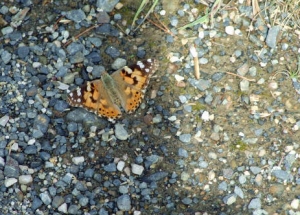
Butterfly, 22 Aug 09.
Now it was just a short walk to another derelict mine, the Cyffty.

The derelict Cyffty mine, 22 Aug 09.
I’m not sure how long a walk it is from Betws y Coed, but the miners who worked here would walk each day from Betws and Llanrwst before a hard days work in this mine. They must have been tired out before they started!
It wasn’t reliable work either. Often it relied on the weather; wet weather could flood the mine and dry spells could mean there was no water to drive the machinery. When they couldn’t work they didn’t get paid, so many of the miners would have small holdings or work on farms too, to help eke out a living.
Downhill now, I set off again. Not too far away is another old lead mine, the Hafna.
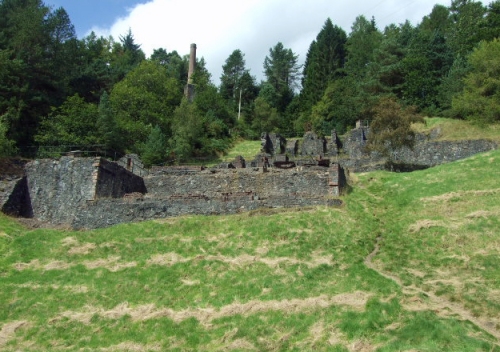
The remains of the Hafna mine, 22 Aug 09.
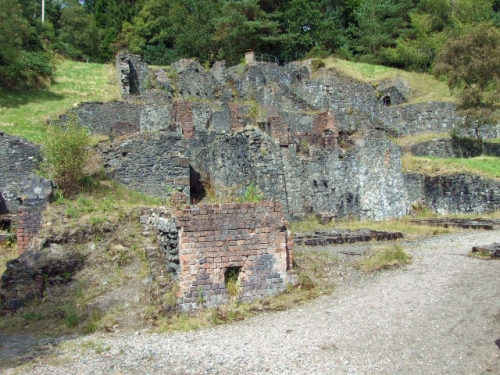
Part of Hafna mine, 22 Aug 09.
After having a look round the remains of the mine I set off again, downhill towards Llanrwst. Before I got back down into the valley though, I took a slight detour to see a lovely little waterfall.
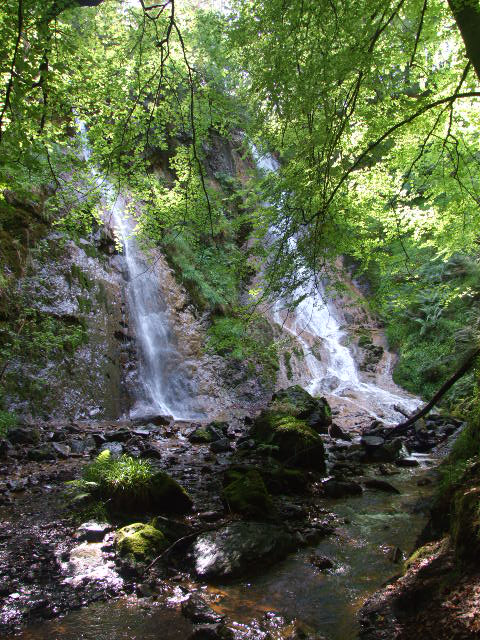
The Grey Mare's Tail, 22 Aug 09.
This is The Grey Mare’s Tail. It is known in Welsh as Rhaeadr y Parc Mawr, but this name is rarely used. The falls are in a lovely wooded glade at Coed Felin Blwm (Lead Mill Wood). It’s well worth making the 200 yard detour to see it, and it lies in a nature reserve so there are other paths to take too.
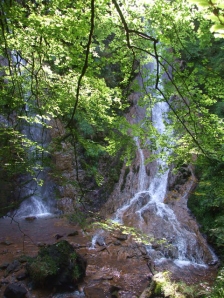
The Grey Mare's Tail, 22 Aug 09.
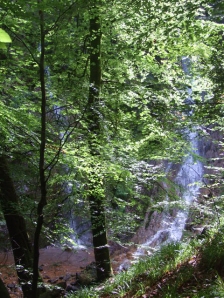
The Grey Mare's Tail, 22 Aug 09.
It’s a steep climb back up to the lane after visiting the falls, but from the top I got a good view of the Conwy valley.
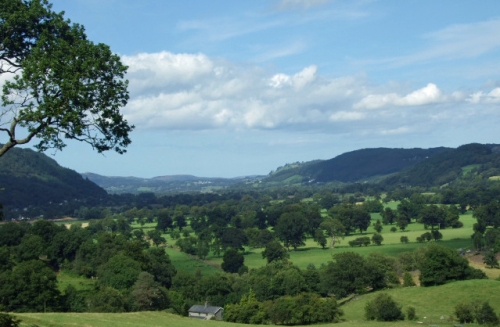
Looking down the lush Conwy valley, 22 Aug 09.
And then it was back to Llanrwst and the sort drive home. It had been a long day and I was glad it would only take a few minutes to get home.
Gwydyr forest is just one more place where there is a lot to explore, I’d only seen a small part today. More information about the activities, trails etc. can be found here: http://www.forestry.gov.uk/gwydyrforestpark
It’s one more place for you to visit; great scenery, history and a labyrinth, what more could you ask for?
Posted in Landscapes/Nature, Local history, tagged bodnant gardens, bodnant hall, conwy valley, flowers, lily pond, mausoleum, national trust, north wales, old mill, pin mill, rose terrace, the dell, trees on August 12, 2009| Leave a Comment »
I last visited the gardens (and did a blog post) in May when they were full of spring colour. Yesterday (11th. Aug) I returned to see how they look in summer.
Bodnant gardens cover an area of about 80 acres, some formal gardens and lawns, and the dell which is a wild area. The gardens were given to The National Trust by Lord Aberconwy in 1949, but are still managed by the family, who continue to live in the hall.
The entrance and reception are fairly new, and make entering the gardens safer. You now walk under the road instead having to cross it. Through reception, and you are met with a colourful border.
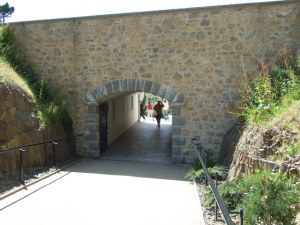
The path under the road.
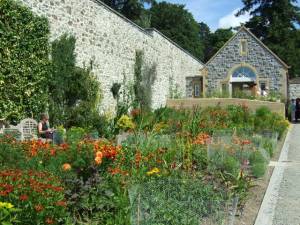
The colourful border with reception in background, 11 Aug 09
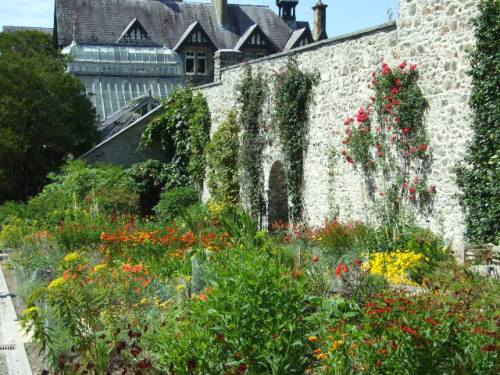
The colourful border leading to the hall. 11 Aug 09
The hall was built in 1792, and was bought in 1874 by Henry Davis Pochin, whose son-in-law was the 1st Lord Aberconwy. At that time the gardens were victorian shrubberies and lawns.
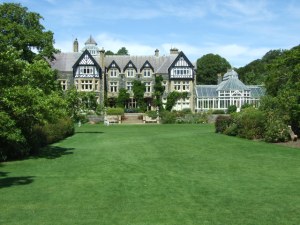
Bodnant Hall and the front lawn. 11 Aug 09
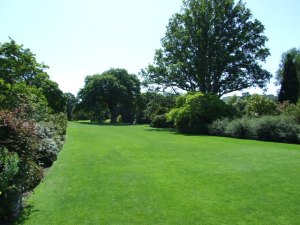
Looking down the front lawn from the hall. 11 Aug 09
As you walk across the front of the building you come to the statue of priapus and a wonderful view across the Conwy valley, before turning to the side of the building and the Upper Rose terrace.

Priapus with hills across the Conwy valley. 11 Aug 09
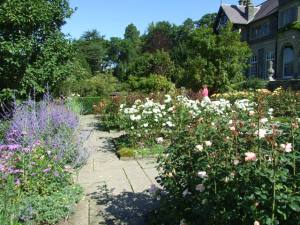
The Upper Rose terrace, 11 Aug 09
In May when I was last here there were no roses in bloom of course. now the terrace is full of colour and the perfume was intoxicating.
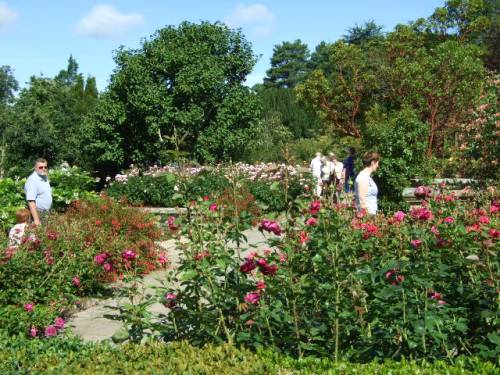
The Upper Rose terrace. 11 Aug 09
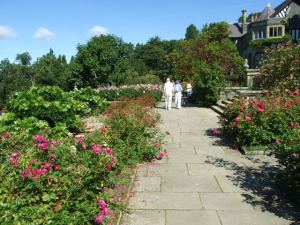
The Upper Rose Terrace. 11 Aug 09
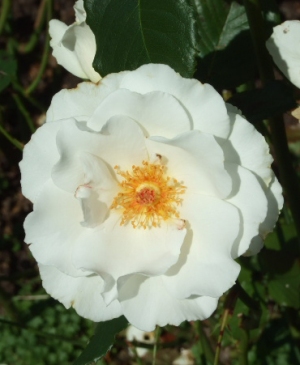
One of the many roses, 11 Aug 09
From the Rose terrace there is also a view across the Lily pond below and across the conwy valley.
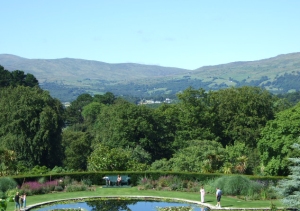
The view across the lily pond and the Conwy valley, 11 Aug 09
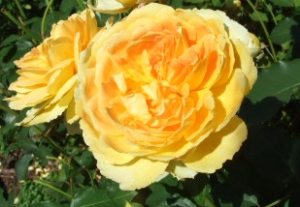
The roses look and smell beautiful. 11 Aug 09
Now I walked down to the Lily Terrace, and the wonderful display of Hydrangeas.
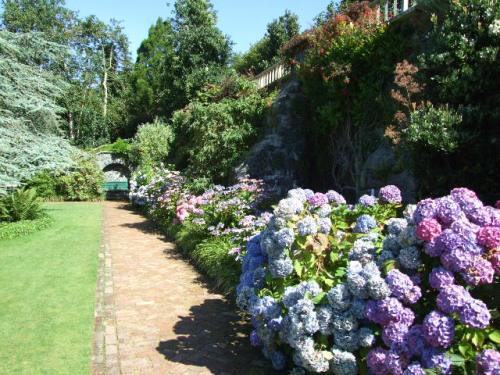
Hydrangeas on the Lily Terrace, 11 Aug 09
The Terrace was designed around the two Cedars which still stand at either end of the Lily Pond.
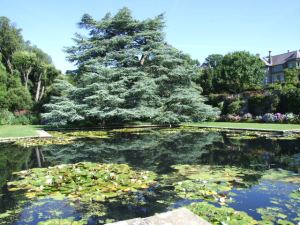
The Lily Pond with one of the original Cedars. 11 Aug 09
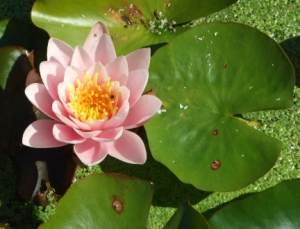
A water-lily, 11 Aug 09
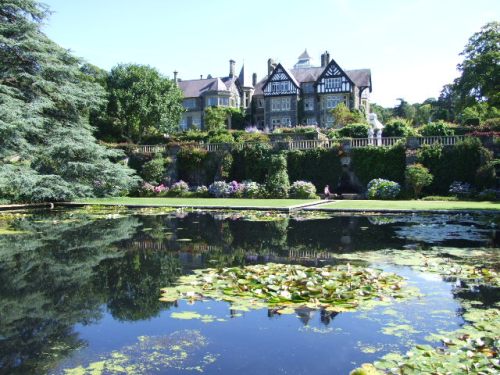
The hall from across the Lily Terrace, 11 Aug 09
After the Lily Terrace I made my way down to The Canal Terrace and Pin Mill, passing more colourful borders along the way.
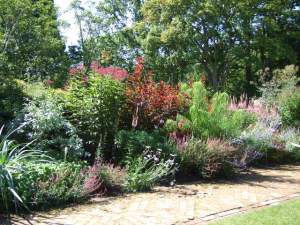
Colourful borders abound, 11 Aug 09
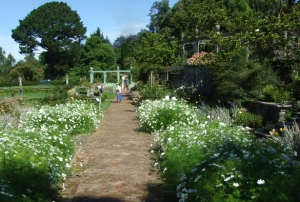
A border leading to the Canal Terrace, 11 Aug 09
The long narrow stretch of water on the Canal Terrace has water-lilies at either end. At the north of the terrace is an open-air stage with a background of clipped Yews. At the southern end of the Terrace is the Pin Mill, originally constructed as a garden house in about 1730 in Gloucestershire. In 1938 it was in a decayed state. Lord Aberconwy bought it and incorporated some of it into the Pin Mill.
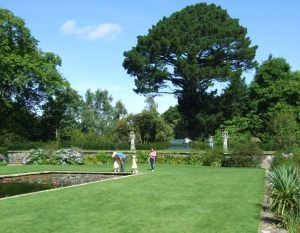
Looking south to the open-air stage, 11 Aug 09
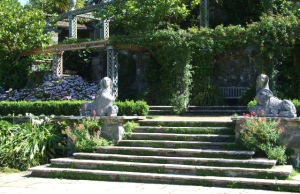
The Spinxes on either side of the steps leading to the Lower Rose Terrace, 11 Aug 09
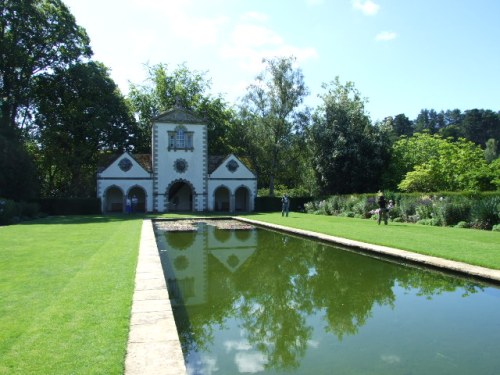
The Pin Mill, 11 Aug 09
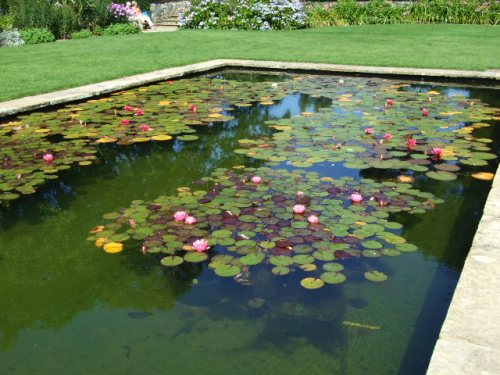
Water-lilies on "The canal", 11 Aug 09
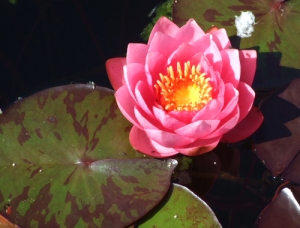
A water-lily. 11 Aug 09
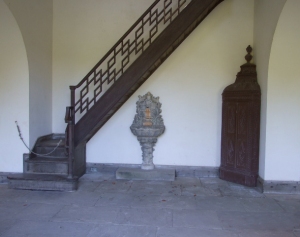
Inside the central arch of the Pin Mill. 11 Aug 09
Leaving the Canal Terrace I made my way down the path leading to the Old Mill. The mill-race is of Tudor origin and was originallu used to power a blast furnace on the banks of Afon Conwy. Later it was used to turn the wheels of the flour mill, and later still to work the estate saw mill.

The mill race. 11 Aug 09
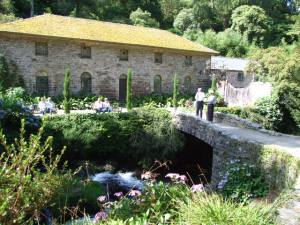
The old mill and stone bridge over the mill-race. 11 Aug 09
The Dell is the wilder part of the gardens, planted with many different conifers as well as Cypress, Wild cherry, Larch etc. The first conifers were planter in 1876 and many are now well over 100 feet high. The most notable are the Wellingtonia, Redwood, Western hemlock and Douglas fir.
Paths run up both sides of the Dell and which ever path you take you will see great tress and a variety of other plants.

Hydrangeas in the Dell. 11 Aug 09
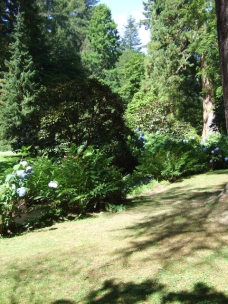
Colour amongst the conifers. 11 Aug 09

The waterfall under the bridge at the head of the dell. 11 Aug 09
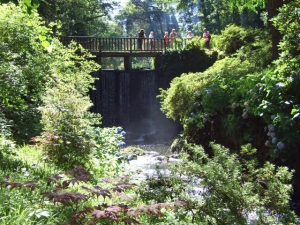
The bridge over the waterfall. 11 Aug 09
Once over the bridge the path climbs alongside a stream, with the colourful Hydrangeas again in evidence.
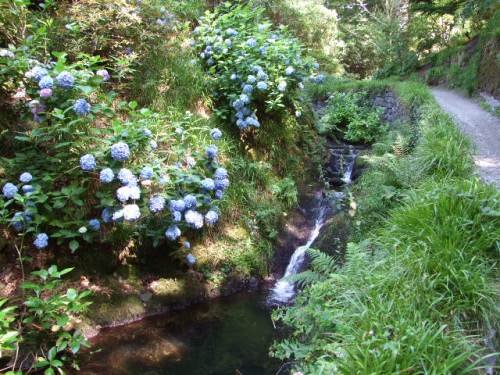
Hydrangeas alongside the path. 11 Aug 09
As I continued up the path I got a view of the mausoleum. This was built by Mr Pochin as a last resting place for himself and his family.

The mausoleum from the path from the Dell. 11 Aug 09
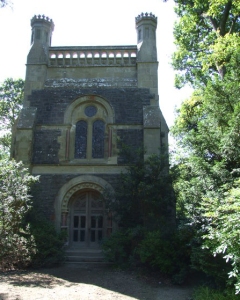
The mausoleum from the forecourt. 11 Aug 09
I now followed paths leading back towards the hall, on the way passing more glorious coloured flowers and wonderful trees.

11 Aug 09

11 Aug 09
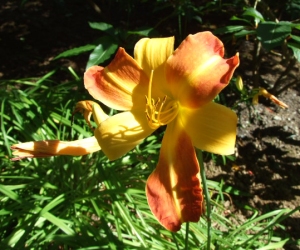
11 Aug 09

11 Aug 09
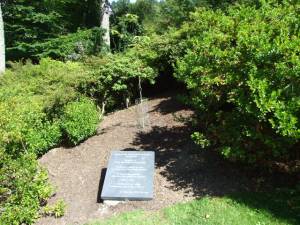
The memorial to Anne McLaren, 11 Aug 09
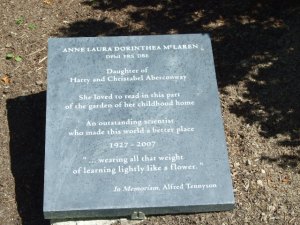
The memorial tablet. 11 Aug 09
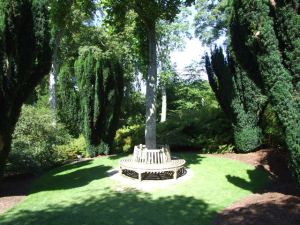
The Yew garden. 11 Aug 09

The round garden. 11 Aug 09
Now I’d arrived back close to the hall. I had another slow walk around the terraces and sat in the sun for a while.
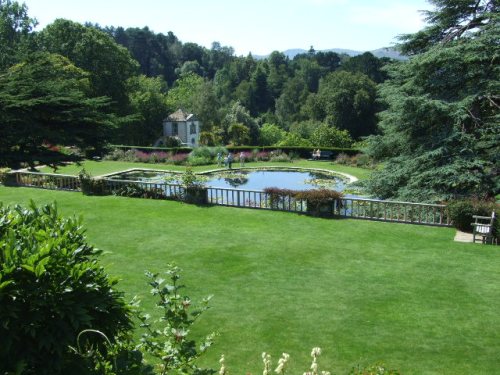
Looking across the croquet terrace & lily pond to the Pin Mill. 11 Aug 09
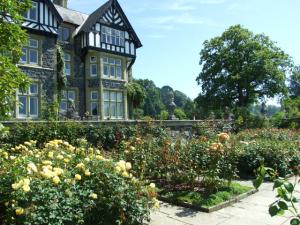
Part of the rose terrace and Hall. 11 Aug 09

Another view of the Pin Mill. 11 Aug 09
Now it’s time to leave and I make my way back to the car park, and a welcome cup of coffee in the refreshment pavilion. Now a last look back, above the roof of Bodnant Hall across the Conwy valley.

The view over the roof of the Hall. 11 Aug 09
If you’re in North Wales it’s worth visiting Bodnant Gardens, it really is a splendid day out. More details, opening times etc can be found here: http://www.bodnantgarden.co.uk/
Posted in Landscapes/Nature, tagged bwlch y ddeufaen on August 6, 2009| 3 Comments »
Just for a change Wednesday 5th. August dawned clear and sunny, so I decided to set off across the othe side of the Conwy valley and up into the northern Carneddau. The way up to the hills from the valley is by a narrow lane which was looking great in the sunshine, the hedgerows colourful with Rowan berries, Meadowsweet, Foxgloves etc. The Meadowsweet reminded me of childhood walks in the Yorkshire dales.
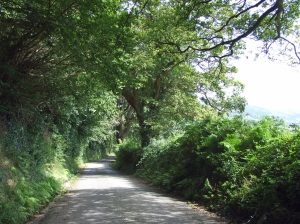
The lane up from the valley. Aug 2009
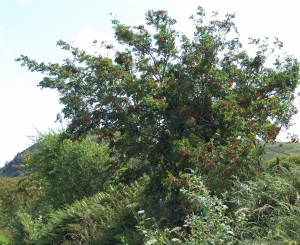
Rowan berries, Aug 2009
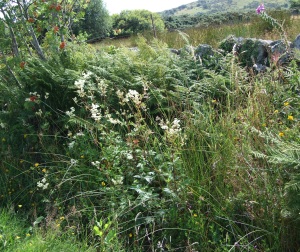
Meadowsweet in the hedgerow, 5 Aug 2009
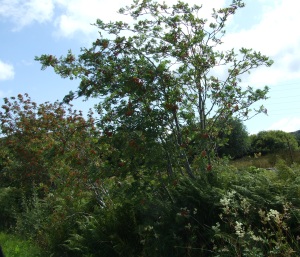
A hedgerow, 5 Aug 2009
Soon the hedgerows are left behind and the scenery becomes wilder. As I made my way along the rough track my only company were sheep, a Kestrel overhead and a few Meadow pipits. Somewhere along the crags I could hear Ravens quarreling loudly.
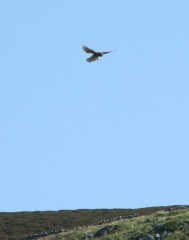
A kestrel hovering overhead, 5 Aug 2009
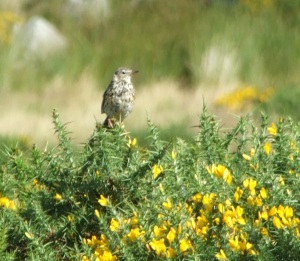
Meadow pipit, 5 Aug 2009
This is what I, as a Yorkshireman would call a wild moor, but the Welsh call the Fridd (mountain pasture). This is typical of the Carneddau; sphagnum moss, cotton grass and reeds grow in the marshy areas, with bilberry, heather and gorse covering the drier areas.
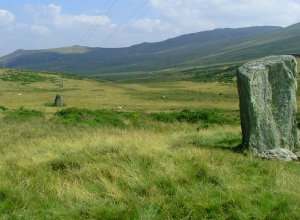
Bwlch y ddeufaen, July 2008.
The standing stones stand on either side of the rough track and are at about 1200/1400 feet above sea level. Only a short walk from here there are stone circles, burial mounds and lots of other ancient sites.
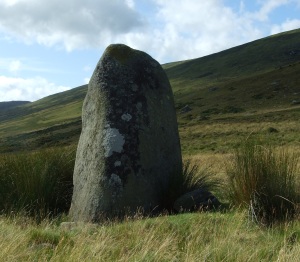
One of the standing stones, 5 Aug 2009
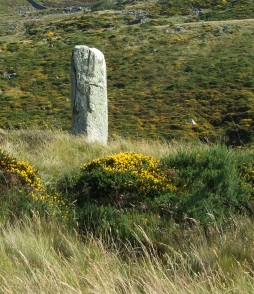
The other standing stone, 5 Aug 2009
Now I left the track and headed up the steep slope of Fridd Cwm-Ithel, stopping frequently to take in the wonderful views to either side.
The only things that spoil the views are the electricity pylons, but even they can’t detract from the scenery completely.

Looking to my right as I climb I can see down the slope to the village of Llanfairfechan and the Menai straits across to Puffin island and Anglesey.
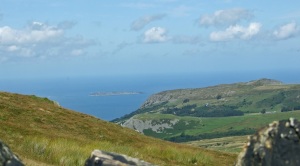
Looking across the Menai strait to Puffin island, 5 Aug 2009
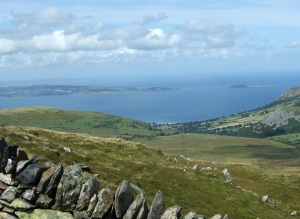
Looking down on Llanfairfechan & across to Anglesey and Puffin island, 5 Aug 2009
Behind me Foel Lwyd looked bleak and barren, rising to 603 metres (1,978 feet) above sea level. Dry stone walls snake up and across these hills, some of them hundreds of years old.

Foel Lwyd, 5 Aug 2009
To my left the fridd stretches away towards the pointed peak of Penygadair with Pen y Gair and it’s tumulus a little lower and more distant.
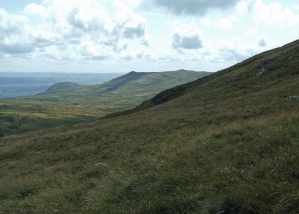
The view across the fridd to Penygadair, 5 Aug 2009
As I climbed higher I looked up to see summer clouds drifting across the lovely blue sky.
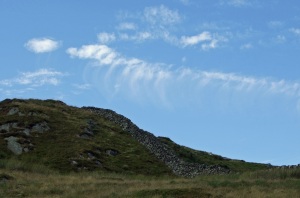
Summer clouds, 5 Aug 2009
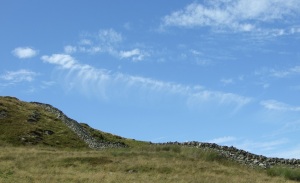
Now at about 2,000 feet above sea level I could look to my left and see right across the Conwy valley and to the Clwydian hills in the distance.
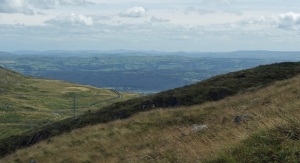
Looking across the Conwy valley to the distant Clwydian hills, 5 Aug 2009
In the opposite direction Llandudno and the Great Orme had come into view.
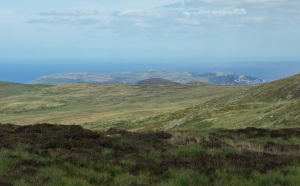
Looking towards the Great Orme and Llandudno, 5 Aug 2009
As I made my way back I again caught some summer clouds above the crags.
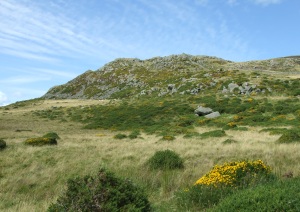
Summer clouds over the northern Carneddau, 5 Aug 2009
It’s wild country up here, but everywhere you look there are fantastic views.
I wish I could have stayed longer, but as I had a ticket for the theatre I had to get back.
As a matter of interest I went to see a performance of “Chicago” at Venue Cymru in Llandudno. It was a fantastic production, well worth leaving the hills for. Venue Cymru get some great productions, so if you’re in the area have a look to see whats on. You can also look them up here: http://www.venuecymru.co.uk/home.php?/home
Posted in Culture, Landscapes/Nature, tagged afon conwy, bala, conwy valley, cwm eigiau, dolwyddelan, eisteddfod, lligwy bay, llyn tegid, north wales, porth dafarch, snowdon, steam railway on August 3, 2009| 4 Comments »
I have said previously that north Wales has wonderful scenery. It’s not all about the mountains of Snowdonia, in fact Snowdonia is not all mountains anyway. I thought I’d put together a few images to show just how varied the scenery is in this part of the world.
To start, here is the Conwy valley, looking down from the hills above Trefriw towards Conwy, Llandudno and the sea.

The Conwy valley looking towards the coast. June 2008

The first bridge over Afon Conwy, just below it's source. Aug 2008

Canada geese near the source of Afon Conwy. May 2008.
North Wales has a great coastline, and the small island of Anglesey has great beaches along with wild, rocky cliffs.

The cliffs around Porth Dafarch. June 2008.

The beach and dunes at Lligwy bay. May 2008.

The little sheltered beach at Porth Dafarch. June 2008.

The sweeping Celmyn bay. June 2009.
And so back to the mainland.

The crags at the head of Cwm Eigiau rise to over 600m. June 2008

Afon Lledr at Dolwyddelan. May 2008.

Snowdon range from below Moel Lechwedd-gwyn. May 2008

Bala steam railway runs alongside Llyn Tegid. July 2009

Llyn Tegid with Bala in the background. 2 Aug 09
Speaking of Bala…….the national eisteddfod is being held there this week. I went to have a look round on Sunday and spent over 6 hours there. What a great day out it is. Here are a few images.

The pavilion (pafiliwn). Also known as the big pink tent. 2 Aug 09.

The big pink tent can be seen from all over the site. 2 Aug 09

A band playing on stage 1. 2 Aug 09

A harp workshop getting under way on stage 2. 2 Aug 09

Maes C is the centre of attraction for younger people. 2 Aug 09

The Bards circle (Cylch yr Orsedd) is used for some performances. 2 Aug 09.

The choir of Ysgol y Gader on stage 2. 2 Aug 09

The bar and food areas get pretty busy. 2 Aug 09

A budding harpist attends a workshop. 2 Aug 09

Pupils of Ysgol y Gader on stage 2. 2 Aug 09

A choir on stage in the pavilion. 2 Aug 09
This was just one of many choirs. They gave a great rendition of Wimoweh (The lion sleeps tonight), in Welsh of course.
Even if you don’t speak Welsh it’s worth visiting, it’s a great day out, particularly if you get good weather. More details can be found at: http://www.eisteddfod.org.uk/english/
Posted in Landscapes/Nature, tagged afon gamlan, alcaic ode, inspiration., north wales, rhaeadr du, snowdonia, thomas gray, woodland on July 17, 2009| 6 Comments »
Close to the lovely Rhaeadr du, in the late 18th century an unknown person cut into a rock lines from Thomas Gray’s Alcaic Ode.
The original carving is barely visible now, but next to the rock is a slate tablet with the original Latin verse and an English translation carved into it.

The stone containing original Latin carving.

The slate tablet containing both Latin and English translation.
The lines from the Ode are so wonderful that I thought that by way of a change I’d reproduce them here, accompanied by some photos taken at and around the falls.
Alcaic Ode by Thomas Gray.
O thou! the spirit mid these scenes abiding,
Whate’er the name by which thy power be known
Truly no mean divinity presiding
These native streams, these ancient forests own
And here on pathless rock or mountain height,

Rhaeadr du.
Amid the torrents ever-echoing road

Afon Gamlan, below the falls.

The headlong cliff, the woods eternal light
We feel the godhead’s awful presence more
Than if resplendent neath the cedar beam,
By Phidins wrought his golden image rose
If meet the homage of thy votry seem
Grant to my youth – my wearied youth – repose.
For any Latin scholars out there here is the original Latin version, and please don’t blame me for the translation. I am most definitely not a scholar of the classics.
O tui, severi religio loci,
Quocunque gaudes nomine non leve
Nativa nam certe fluenta
Numen habet veteresque silums,
Presentiorum et conspicimus Deum

Rhaeadr du.
Per invias rupes fera per juga,
Clivosque praeruptos sonantes
Inter aquas, memorumque noctem
Quam si repostus sub trabe citrea

Afon Gamlan
Fulgeret auro el Phidiaca manu
Salve convanti rite fesso et
Da placidam juveni quitem.

Afon Gamlan
This is a lovely wooded valley which is maintained by the National Trust. Not only did it inspire the unknown person to engrave the melancholic ode, but it also inspired artists such as Turner and Gainsborough.
Visit it yourself and be inspired.
Posted in Landscapes/Nature, tagged afon eden, afon gain, afon gamlan, afon mawddach, coed y brenin, disused mines, forest, mawddach falls, north wales, pistyll cain, rhaeadr du, rivers, snowdonia, waterfalls on July 16, 2009| 7 Comments »
Coed y Brenin (The King’s forest) covers 9,000 acres lying within the Snowdonia National Park.
Originally it was part of the Nannau Estate, then became the Vaughan Forest. It became Coed y Brenin in 1935 to celebrate the silver jubilee of king George 5th.
There is forest, open heath land, rivers and waterfalls here, with plenty of wildlife. If you’re lucky you may see Fallow deer in some of the clearings, and there are lots of woodland birds. You will also probably see disused mine buildings, copper and iron were mined here, as well as gold. Coed y Brenin gold has been used for making rings for the royal family.
The wonderful eco-friendly visitor centre is a good place to start.
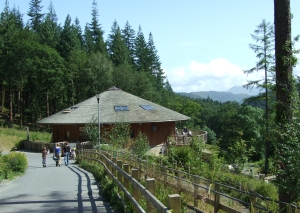
Coed y Brenin visitor centre, 15 July 09.
There’s lots of car parking space here, and the centre has a cafe, information desk, mountain bike shop and toilets. There is a verandah to sit out on, childrens play area, and lots of trails start here too.
All the trails are well way-marked, and are graded too. There are tracks for walking, mountain biking and running. There are some especially for wheelchairs too.
Afon Eden runs through the forest close to the visitor centre. There is a short, easy path which leads you down to the river and alongside it.
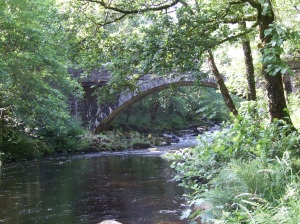
Afon Eden, 15 July 09.
This trail is only about a mile long, and is suitable for wheelchairs. There is a picnic site close to the river, and some lovely scenery.
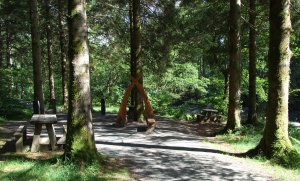
Picnic site beside Afon Eden, 15 July 09.
The path way-marked in red leads to the two wonderful waterfalls. This path is classified as “strenuous”, and I have to agree with that. It has some steep ascents, some using rough paths. It is still a great walk however.

One of the paths on the red route, 9 July 09.
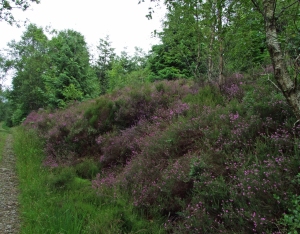
Ling in flower beside a path, 9 July 09.
On the path up through the dense conifers look out for the Wood ants. You may see the nests before the ants…..they keep adding to them and some are huge.
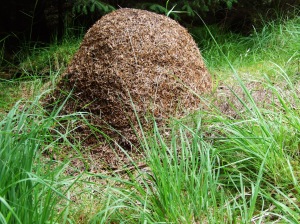
A wood ants nest, 9 July 09.
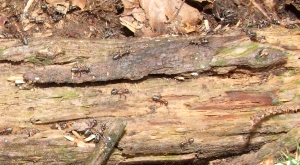
Ants using an old branch as a road back to the nest, 9 July 09.
If you prefer a less strenuous walk to the waterfalls there is an easier route starting from Tyddyn Gwladys, near Ganllwyd. This route has fewer ascents, following Afon Mawddach and then the Gain up to the two falls. As you follow the path alongside the river you pass a small row of cottages. Mostyn cottages were originally built for workers from the mines.
Just a little further along is Ferndale. This was once workshops and a blasting plant for the mines but is now a small holiday complex.
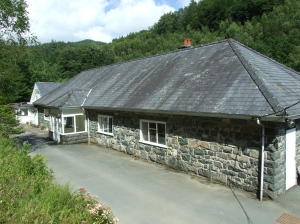
Ferndale, 15 July 09.
And then it’s onwards, following the river, and it’s not too long before you hear the roar of the falls.

Pistyll Cain, 15 July 09.
The first view of Pistyll Cain (Cains waterspout) is from a small bridge over Afon Gain.

Pistyll Cain, 15 July 09.
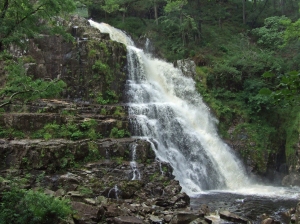
Pistyll Cain, 15 July 09.
There is a rough, narrow path to get closer to the falls, but be careful, some of the stones get slippery when wet. It’s an impressive cascade though, splashing 148 ft against the black rocks and into the pool below. We’ve been having some heavy showers during the last week or so which has filled up the rivers. When I was here a week ago the falls looked like this.

Pistyll Cain, 9 July 09.
Just a few yards from Pistyll Cain, by some ruined mine workings is Rhaeadr Mawddach. Maybe not quite as graceful but you can hear the thunder of the torrent before you see the falls.
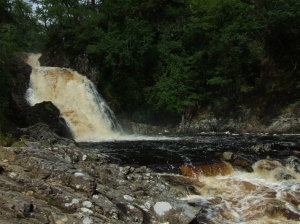
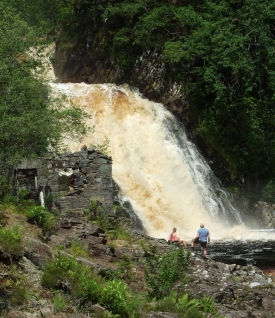
RRhaeadr Mawddach, 15 July 09.

Rhaeadr mawddach, 15 July 09.

Rhaeadr Mawddach, 15 July 09.
Once again the heavy showers of the last few days had made a big difference. This was the falls last week, but however much water is pouring over them they are still worth seeing.

Rhaeadr Mawddach, 9 July 09.
There are disused mine workings all over the forest, like this one near the falls.
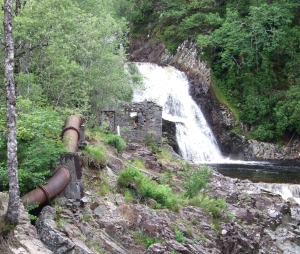
Disused mine workings at Rhaeadr Mawddach, 9 July 09.
If you fancy a bit of a climb you can go up and see the old Gwyfynydd mine, the last of the gold mines to close. It’s not a long walk up to the mine, but I’m moving on up above the falls and then back down river.
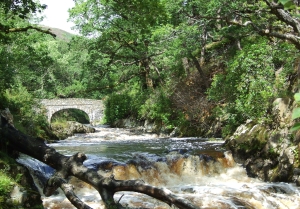
Afon mawddach above the falls, 15 July 09.

Afon Gain joins the Mawddach just below the falls, 15 July 09.
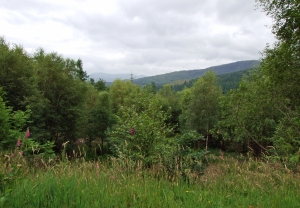
View from a glade, 9 July 09.
Near the village of Ganllwyd another river, the Gamlan meets the Mawddach. Although the rivers meet in the forest, Afon Gamlan is not in Coed y Brenin, so I’m cheating a little here, but it’s worth it.
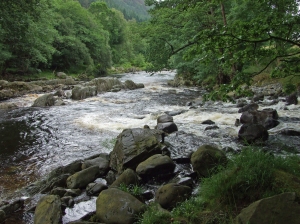
Afon Gamlan joins the Mawddach, 15 July 09.
You follow Afon gamlan towards the village, then cross the A470 next to the memorial hall. A path then leads up to the hillside to Rhaeadr du (Black falls).
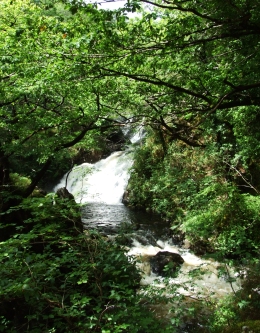
Rhaeadr du, 15 July 09.
These lovely little falls inspired artists such as Turner and Gainsborough.

Rhaeadr du, 15 July 09.
A stone stands near the falls, on which, during the late 18th century an unknown person carved lines from Thomas Gray’s Alcaic Ode, in latin.

Carved stone near Rhaeadr du, 15 July 09.
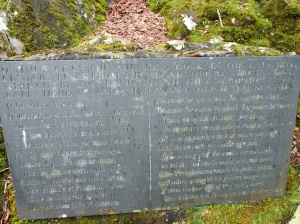
The original Latin along with translation. 15 July 09.
From here the Gamlan thunders over rocks as it rushes down the steep valley to join the Mawddach.
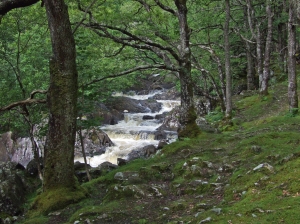
Afon Gamlan, 15 July 09.
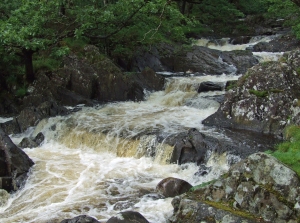
Afon Gamlan, 15 July 09.

Afon Gamlan, 15 July 09.
There are some lovely walks around rhaeadr du and further up (including more disused mines), but now I’m heading back to Coed y Brenin visitor centre for a cup of coffee, and maybe a stroll through the woodland afterwards.

A path through woodland in Coed y Brenin, 15 July 09.
There is so much to see and do around Coed y Brenin. One visit is just not enough. Give it a try, you’ll love it.
Have a look at the Forestry Commission website too. There’s a good little video on there. http://www.forestry.gov.uk/website/recreation.nsf/LUWebDocsByKey/WalesGwyneddNoForestCoedyBreninCoedyBreninVisitorCentre
Posted in Landscapes/Nature, Local history, tagged crib goch, hafod eryri, llanberis, north wales, snowdon, snowdonia, steam railway, y lliwedd, yr wyddfa on June 25, 2009| 9 Comments »
You can’t live in north Wales (and blog about it) without mentioning Snowdon, so after about 11 months of this blog I thought I’d better put that right.
Tuesday 24th June dawned bright and sunny, so I made an early start. Up the valley to Betws y Coed and then up the Llugwy valley to Capel Curig. Just after passing through the village you come to Llynau Mymbyr, and this is where you get your first view of the famous Snowdon horseshoe.

First view of the Snowdon horseshoe. 24 June 09.
Then it was onwards, over the Llanberis pass, down into the valley and onto the village of Llanberis.
There are 3 main paths up to the summit of Snowdon. The Llanberis path, unsurprisingly starts at Llanberis, close to the Snowdon mountain railway station. It starts along a narrow road, soon becoming steep as you turn onto a stony path. The first third of the walk is steep, but very soon there is wonderful scenery all around. looking back you get a wonderful view of the village and Llyn Padarn.

Llanberis and Llyn Padarn. 24 June 09.
Climbing a little higher you can look back and see the huge slate quarries cut into the hillside above the valley.

Halfway up is the Halfway cafe where you can stop for refreshments. It used to be a wooden hut but that was blown down in a gale a few years ago. It’s now a more substantial building.
As you continue your walk you’ll probably see the steam trains chugging their way up some of the steep inclines. The railway was built in 1896, more wonderful Victorian engineering.

The train makes it's way slowly up an incline. 24 June 09
The path continues upwards, getting steeper agin for the last third. It’s a rocky path and good footwear should be worn. Many people have accidents and twist their ankles every year because they wear trainers or sandals.

The path with Clogwyn Coch in the background. 24 June 09.
I should add here that I’m no expert, so feel free to correct any mistakes I make with names etc.
The path continues to climb, up to where the Pyg path and Miners path meet it. These two paths start at Pen-y-Pass. One running alongside Llyn Llydaw and the Pyg path running below the ridge of Crib Goch.

The path to Pen-y-Pass. 24 June 09.
Crib Coch means “Red comb”. The ridges leading to it are knife edge, with steep drops on either side. This is not a walk for beginners, even in good weather, and in bad weather even experience climbers need good equipment. The peak of Crib Goch is 923 metres (3, 028 feet).

Llyn Llyddaw lies in a bowl between Crib Goch and Y Lliwedd.

From here the path gets even steeper as it heads for the summit of Snowdon.

The last push up to the summit.
Yr Wyddfa means “the tumulus”. Legend has it that a giant called Rhita Gawr who lived here killed kings and used their beards to make cloaks to keep himself warm. Eventually though he come up against King Arthur, who killed him. Everyone then placed rocks over his body to form the summit.
Onwards and upwards, and after the last steep climb the new visitor centre comes into view.

Hafod Eryri. 24 June 09.
Hafod (summer residence) Eryri (Snowdonia) was opened in early June 2009. It was about a year late in opening, but the workers had to suffer some atrocious conditions.
It is built of local granite and the inside is lined with local Oak. It has to withstand winds up to 150 mph, about 200 inches of rain per year and temperatures of -20 deg C.
It’s a wonderful building, blending in with it’s surroundings and the wall of glass at the front gives fantastic views.

The view from Hafod Eryri. 24 June 09.
Prince Charles famously called the old building, “the highest slum in Britain”. Well Hafod Eryri is certainly not a slum, it’s a wonderful building, and everyone concerned should be congratulated.
Out through the back door, and it’s a few more steps up to the actual summit.

The summit of Snowdon. 24 June 09
Snowdon is the highest mountain in England and Wales, standing at 1,085 metres (3,560 feet). Down in the valley it was over 20 deg C, but up here there was a strong, cool wind. The weather can change in minutes up here but I was lucky, it was a gorgeous sunny (warm lower down) day.
Y Lliwedd is is the other peak which makes up the famous Snowdon horseshoe, and stands at 902 metres (2, 595 feet).

Y Lliwedd from near the summit of Snowdon. 24 June 09.
This had been a wonderful day. History, fantastic scenery and great weather. Tiring but wonderful. I’ll end this post with a few miscellaneous photos, and invite you to visit Snowdon and experience it first hand.







Posted in Historical, Landscapes/Nature, tagged afon mawddach, coed y groes, foel cynwch, llyn cynwch, nannau estate, north wales, precipice walk on June 18, 2009| 9 Comments »
Tuesday 16th. June dawned bright and sunny so I set off towards Dolgellau. The start of the precipice walk is at Coed y Groes, on the narrow road between Dolgellau and Llanfachreth.
The walk lies on the Nannau Estate which grants permission for use of the footpaths.
There has been a house at Nannau since the 12th. century, when the estate was owned by Cadwgan, Prince of Powys. The original building was burned down in 1404 after trouble between the owner, the 8th. Earl of Nannau and his cousin Owain Glyndwr.
The house wasn’t rebuilt until 1693. The Nannau family (who became the Nanney’s), still lived on the estate, but were having financial problems. Hugh Nanney was imprisoned for trying to sort out his financial prblems by cutting down 10,000 Oak trees.
When the male line died out the female line, which had married into the powerful and influential Vaughan family, took over and replanted many of the trees. In 1796 they built the grand mansion that stands today.
The early part of the walk crosses woodland and farm pasture. Nannau Hall stands to the south east, and you can glimpse it through the trees as you start the walk.

Nannau Hall.
As the path starts the slight ascent up around Foel Cymwch you get your first sight of Llyn Cymwch in a hollow surrounded by woodland.

Llyn Cymwch from the north.
As the path ascends and rounds Foel Cymwch spectacular views open up. The first photo is the view to the east; the lush foothills and pasture land of this part of Wales. The second photo is the view across Coed Dôl-y-clochydd towards the peaks of Snowdonia.

Looking north east from the side of Foel Cymwch.

Looking over Coed Dol-y-clochydd.
I could have spent hours sat here. The views in any direction were stunning and it was so peaceful. All I could hear as I sat looking out over the wonderful landscape was bird song, the occasional sheep and the breeze rustling through the bracken. The sun was bright and warm and it was a shame that I had to move, but the precipice was just around the corner.
The narrow path winds it’s way along a terrace on the slope of Moel Cymwch with the Mawddach valley down below. The path is quite rocky in places so good boots are definitely a good idea.

The precipice footpath.

The Mawddach valley from the precipice footpath.

The precipice footpath.
The precipice path itself is just over a mile, with the occasional twist and turn to add interest. As you reach the southern end, below Foel Faner, more beautiful scenery opens up in front of you.
Straight in front of you Afon Mawddach meanders through the plain of Dolgellau, on through sand banks before reaching the sea. Just to the left are the northern cliffs of the Cadair Idris mountains.
Once again this is a place just to sit and take in the views and the peace.

Afon Mawddach meanders to it's estuary.

The northern cliffs of the Cadair Idris mountains.
It’s a shame, but once again I have to move on. Now the path turns to the left and descends to the shores of Llyn Cymwth. The scene is still peaceful, with just a few fishermen on the banks of the lake. The walk back to the car park is along the tree lined banks of this lovely little lake.

Llyn Cylmwch from the southern end.

Fishermen line the banks of Llyn Cylmwch

Fishing on Llyn Cymwch
The precipice walk starts and ends at Coed y Groes. It’s only about a 4 mile walk so you can have an afternoon stroll or make a day of it. There are a couple of picnic tables at the car park, but there are plenty of places to sit on the way round. Whichever you prefer, the precipice walk is definitely worth a visit.